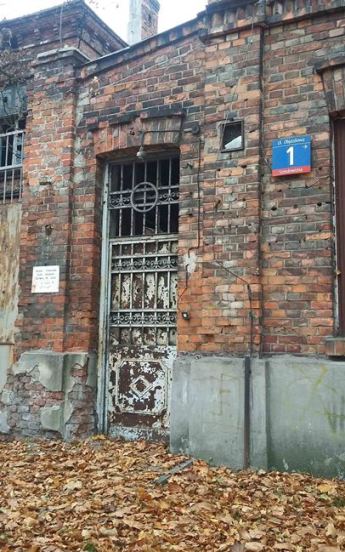
-
 Thank you for your method for mincing jalapeno peppers. I use it!
Przez:domowypatchwork 29Dec2020
Thank you for your method for mincing jalapeno peppers. I use it!
Przez:domowypatchwork 29Dec2020 -
 Thank you!
Przez:domowypatchwork 29Dec2020
Thank you!
Przez:domowypatchwork 29Dec2020 -
 Inka is our chickory coffee. I think that you can use any kind of coffee ...
Przez:domowypatchwork 29Dec2020
Inka is our chickory coffee. I think that you can use any kind of coffee ...
Przez:domowypatchwork 29Dec2020 -
 What a wonderful idea! I will make this with blackberry preserves, without the ...
Przez:Andrea 23Dec2020
What a wonderful idea! I will make this with blackberry preserves, without the ...
Przez:Andrea 23Dec2020 -
 This fish soup looks delicious!
I love soup.
Przez:Andrea 22Dec2020
This fish soup looks delicious!
I love soup.
Przez:Andrea 22Dec2020
Szmulki - Warsaw's hidden treasure - Praga
Even though I have lived in Warsaw since the day I was born, Praga has always been for me just a working district. For walks and sightseeing I preferred not to go there. Lately, by chance, I discovered that this was a big mistake. A few days ago I went walking along the unique streets of the Szmulki District. This disreputable part of Praga turned out to be a treasure. I found there remote and recent history, relics and some elements of modern architecture.
The name "Szmulowizna" comes from the owner of the local grounds Szmul (Samuel) Jakubowicz Sonnenberg, alias Zbytkower – a Jewish merchant, banker and protégé of the Polish king Stanisław August Poniatowski. This rich Warsaw Jew made big money from deliveries for the Russian army. In the beginning Zbytkower's farm name was Bojnówek, but later on, together with the surrounding parts (village and tavern), he adopted the owner's name, Szmulowizna. With the passage of time, the Szmulowizna grounds developed and industrial and residential buildings were built. Jewish families made up a significant part of the population living there.
After World War II, the flats left by Jewish families were taken over by poor people from Warsaw's suburbs, and the Praga neighborhood, Szmulki in particular - despite industrial and transport development - gained notoriety. Today, after many years without proper care, the old houses have started to regain their old appearance. New housing estates are being built on Szmulki. Here you may find the longest building in Warsaw. The 508-meter-long apartment building is located near Kijowska street.
In the years 1907-1923, following Łukasz Wolski's design and with the support of the Radziwiłł family, a church was built, which was given the honourable name of Basilica. Accordingly to its founders wishes, starting from 1931, Salesians would take care of this building and do all the priestly work. Basilica was the biggest church in pre-war Warsaw. The temple is 65 meters in length, with a width of 30 meters, and is 22 meters high. Its size makes a really huge impression. Pope Pius XI used to say that this temple was the most beautiful church in Poland. Today the inside of the renovated Basilica is used as a concert hall.
In one of the side streets behind the modern sports center, I found a gem: the "Drucianka" factory, which is in fact the Warsaw Wire Panel Pin and Nail Factory, also known as the Belgian Wire Factory. This picturesque ruin has been spoilt over time by vandals and scrap metal collectors. It is now listed in the Provincial Monument Register, but between the First and Second World Wars it used to employ 360 people. On the outside wall you may read a tablet with information about its turbulent war history. The factory was closed in 2000 after 101 years of functioning.
The factory together with the opposite facing old Michla mill complex form today a unique relict of industrial architecture from the edge of the XIX and XX centuries on Szmulowizna. The Michla mill complex, a relict of food industry architecture, consisted of a steam mill, breadbasket and gatehouse. Both buildings also have an important cultural value as one of the most important industrial factories of old Praga, which significantly influenced the industrial character of Szmulki.
If we get off the main Kawęczyńska street we have a chance to walk on cobbled streets, which seem to have been relocated directly from the XIX century. The facades of many of the tenement houses we passed have bullet holes from the Second World War. To my amazement, seemingly stuck to one of the brick-built buildings, it says "Drewniak Burkego". This unusual tenement from 1890 is one of two wooden houses left in Northern Praga. The second building is on Środkowa street, the house of Lisiecki's "Grandfather". This building has survived both wars, but even though it still delights with its exquisite realization, without the right care, protection and renovation, we will shortly be able to call it the relict with a soul.
A significant part of Praga's Szmulki is covered by a factory complex from the end of the XIX century - Warsaw Vodka Factory "Koneser". The distinctive red-brick buildings, narrow windows, turrets and the unique main gate from Ząbkowska street have gained a new shine after revitalization. Praga Koneser Center intends to infuse new life into the factory space, create a cultural center, and arrange lofts and residential, office and merchant buildings. There are plans to create a Polish Vodka Museum as well.
During today's walk I realized how much we lose by looking only at listed buildings that are in the spotlight. Sometimes it is worth going off the main trail, getting lost among the side streets and finding something which is not visible from the front.
















